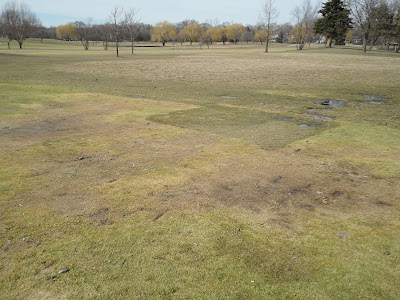Compared to last year, it looks like we will have only limited areas of winterkill this spring. In 2010, a long period of snow cover and a long period of freezing and thawing of ice sheets resulted in a lot of lost annual bluegrass (
Poa annua). We sodded the worst areas and slit seeded the rest. For pictures from 2010, see "
7th Fairway- Update."
 |
| Sodding areas of the 6th fairway in 2010 |
If you see any strange patterns or lines in the fairways this March or April, it may be areas sodded with bentgrass in 2010. Pictures like the ones below really illustrate the weaknesses of annual bluegrass compared to creeping bentgrass or Kentucky bluegrass.
 |
| Bentgrass sod design on 6 fairway |
 |
| Another square on 6 fairway from 2010 |
 |
| Creeping bent on the left -- Annual bluegrass on the right |
 |
| Large square sodded in 2010 |
These areas have 2 problems that go together: poor drainage (they are naturally low and almost flat) and poor turf species. While it will take a combination of approaches to improve these areas of the fairways, I am glad to see that bentgrass is capable of surviving the winter in these difficult spots. It shows that keeping up with our current strategies will improve these areas in the long term.
Right now, you can really see the contrast between different grass species and their reaction to cold temperatures. Unfortunately, most of the brown areas around our sod from 2010 will green up with warmer temperatures. I say "unfortunately" because it would be a lot easier to get rid of annual bluegrass if it would die off and stay dead. Its persistance is amazing. It will die in a heartbeat in the winter and summer and re-germinate just as fast in the spring and fall.














